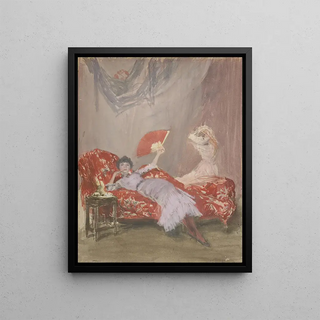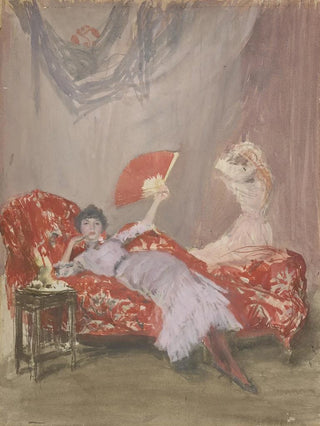Art print | Milly Finch - James Abbott McNeill Whistler


View from behind

Frame (optional)
In the enchanting world of art, some works manage to transcend time and capture the very essence of beauty. "Milly Finch - James Abbott McNeill Whistler" is a striking example. This piece, highlighting a delicate and mysterious female figure, invites us to delve into a world where light and shadow meet in rare harmony. Whistler, master of composition and color, succeeds in creating an intimate atmosphere, where each nuance seems to tell a story. The art print of this iconic piece allows for rediscovering the finesse of his stroke and the depth of his message, while offering a window into the 19th-century artistic universe.
Style and uniqueness of the work
Whistler's style is often characterized by his innovative approach and sensitivity to light. In "Milly Finch," he manages to capture the essence of a fleeting moment, transforming a simple scene into a poetic exploration of life. The colors used, subtly nuanced, evoke an atmosphere that is both gentle and melancholic. The pose of Milly Finch, both natural and posed, demonstrates a delicate balance between movement and tranquility. Whistler excels in the art of suggestion, leaving it to the viewer to interpret the feelings and thoughts of his model. This work is an invitation to contemplate the ephemeral beauty of life, to appreciate every detail, every shadow, every flash of light.
The artist and his influence
James Abbott McNeill Whistler, an emblematic figure of the Impressionist movement, knew how to mark his era with his boldness and unique vision. Born in 1834, he was influenced by the great European masters but also developed a style that is his own, combining modernity and tradition. His artistic approach, which values harmony of colors and composition, has inspired many artists around the world. Whistler does not merely reproduce reality; he seeks to express emotion and transcend the everyday. The impact of his work is felt not only in painting but also in decoration and design, where his aesthetic sense continues to

Matte finish

View from behind

Frame (optional)
In the enchanting world of art, some works manage to transcend time and capture the very essence of beauty. "Milly Finch - James Abbott McNeill Whistler" is a striking example. This piece, highlighting a delicate and mysterious female figure, invites us to delve into a world where light and shadow meet in rare harmony. Whistler, master of composition and color, succeeds in creating an intimate atmosphere, where each nuance seems to tell a story. The art print of this iconic piece allows for rediscovering the finesse of his stroke and the depth of his message, while offering a window into the 19th-century artistic universe.
Style and uniqueness of the work
Whistler's style is often characterized by his innovative approach and sensitivity to light. In "Milly Finch," he manages to capture the essence of a fleeting moment, transforming a simple scene into a poetic exploration of life. The colors used, subtly nuanced, evoke an atmosphere that is both gentle and melancholic. The pose of Milly Finch, both natural and posed, demonstrates a delicate balance between movement and tranquility. Whistler excels in the art of suggestion, leaving it to the viewer to interpret the feelings and thoughts of his model. This work is an invitation to contemplate the ephemeral beauty of life, to appreciate every detail, every shadow, every flash of light.
The artist and his influence
James Abbott McNeill Whistler, an emblematic figure of the Impressionist movement, knew how to mark his era with his boldness and unique vision. Born in 1834, he was influenced by the great European masters but also developed a style that is his own, combining modernity and tradition. His artistic approach, which values harmony of colors and composition, has inspired many artists around the world. Whistler does not merely reproduce reality; he seeks to express emotion and transcend the everyday. The impact of his work is felt not only in painting but also in decoration and design, where his aesthetic sense continues to






